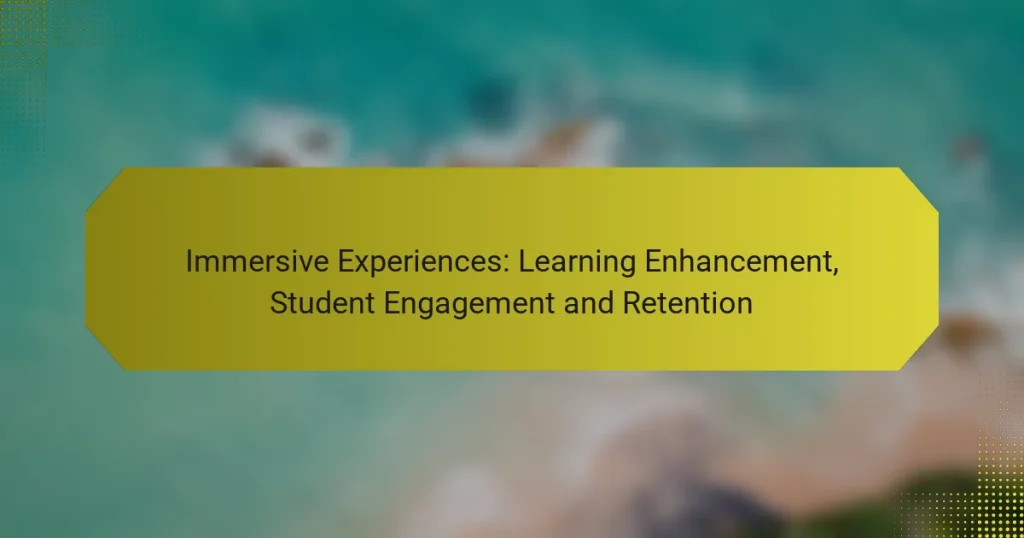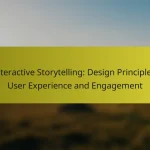Immersive experiences are transforming education by engaging students in interactive environments that foster deeper understanding and retention of knowledge. By leveraging technology to create realistic scenarios, these experiences not only enhance learning but also significantly boost student engagement and retention rates, making education more impactful and meaningful.
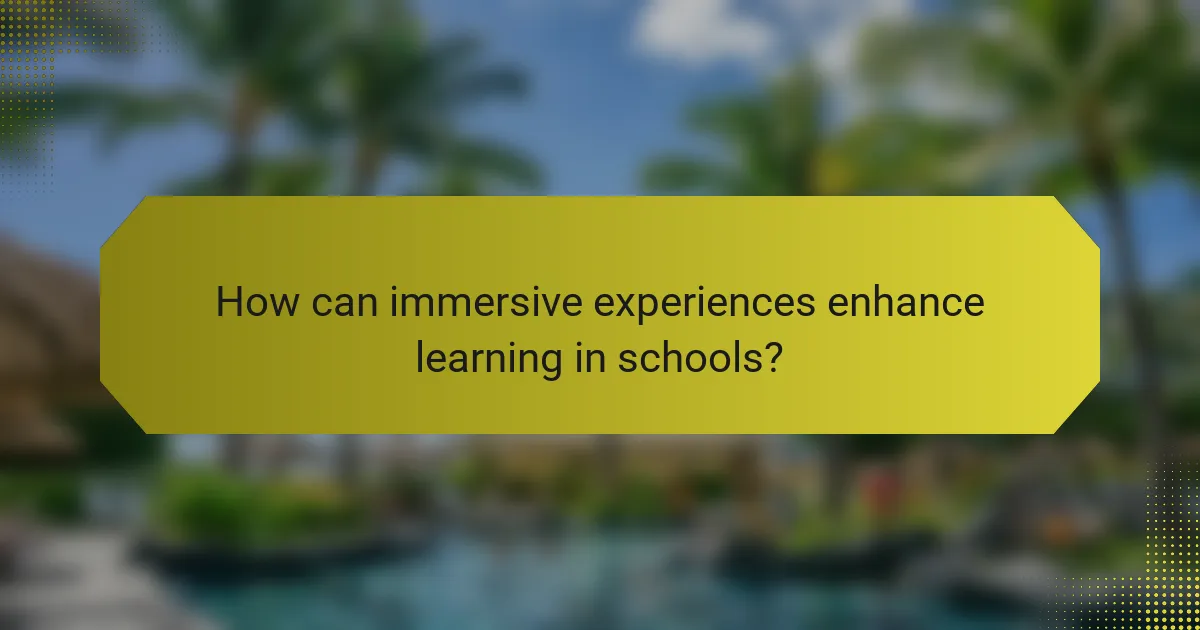
How can immersive experiences enhance learning in schools?
Immersive experiences can significantly enhance learning in schools by engaging students in interactive environments that promote deeper understanding and retention of knowledge. These experiences often leverage technology to create realistic scenarios, allowing students to apply concepts in practical settings.
Virtual reality applications
Virtual reality (VR) applications immerse students in 3D environments where they can explore complex subjects, such as history or science, in an engaging way. For example, a VR program might allow students to walk through ancient civilizations or conduct virtual chemistry experiments. This hands-on approach can lead to improved comprehension and retention compared to traditional learning methods.
When implementing VR in classrooms, consider the necessary hardware and software requirements, as well as the training needed for educators. Schools should also evaluate the cost-effectiveness of VR solutions, as prices can vary widely based on the technology used.
Augmented reality tools
Augmented reality (AR) tools enhance the real-world environment by overlaying digital information, making lessons more interactive. For instance, AR applications can bring static images in textbooks to life, allowing students to visualize complex concepts like the human anatomy or planetary systems. This interactive element can boost student interest and engagement.
To effectively integrate AR into the curriculum, schools should ensure that devices such as tablets or smartphones are available and that teachers are trained to use these tools effectively. It’s also essential to select AR content that aligns with educational standards and learning objectives.
Interactive simulations
Interactive simulations provide students with opportunities to experiment and make decisions within a controlled environment, mimicking real-life scenarios. For example, a simulation might allow students to manage a virtual ecosystem or run a mock business. These experiences can foster critical thinking and problem-solving skills.
When choosing simulations, educators should consider the relevance to the curriculum and the level of interactivity offered. It’s beneficial to incorporate simulations that allow for collaboration among students, enhancing teamwork and communication skills.
Gamification strategies
Gamification strategies involve applying game design elements in educational contexts to motivate students and enhance learning. This can include point systems, leaderboards, and rewards for completing tasks. By turning learning into a game, students may feel more engaged and willing to participate actively.
To implement gamification effectively, educators should focus on clear objectives and ensure that game elements align with learning goals. Avoid over-rewarding, as it can lead to a focus on extrinsic motivation rather than intrinsic learning.
Case studies from US schools
Several US schools have successfully integrated immersive experiences into their curricula, demonstrating positive outcomes. For instance, a middle school in California implemented VR field trips, resulting in higher student engagement and improved test scores in social studies. Another school in New York used AR tools to enhance science lessons, leading to increased student interest in STEM subjects.
These case studies highlight the importance of aligning technology with educational goals and providing adequate training for teachers. Schools considering similar implementations should evaluate their specific needs and resources to ensure successful adoption of immersive experiences.

What are the benefits of immersive experiences for student engagement?
Immersive experiences significantly enhance student engagement by creating interactive and stimulating learning environments. These experiences foster deeper connections to the material, leading to increased interest and retention among students.
Increased motivation
Immersive experiences can boost student motivation by making learning more enjoyable and relevant. When students engage in activities that simulate real-world scenarios, they often feel a stronger desire to participate and succeed.
For example, using virtual reality to explore historical events can spark curiosity and enthusiasm, encouraging students to delve deeper into the subject matter. This heightened motivation can lead to improved academic performance and a more positive attitude towards learning.
Improved collaboration
Collaborative immersive experiences promote teamwork and communication among students. By working together in simulated environments, learners can develop essential social skills and learn to value diverse perspectives.
Group projects that incorporate immersive technology, such as augmented reality, can facilitate problem-solving and foster a sense of community. This collaborative approach not only enhances learning outcomes but also prepares students for future workplace dynamics.
Enhanced critical thinking
Immersive experiences challenge students to think critically and make decisions in real-time. These scenarios often require learners to analyze information, evaluate options, and consider consequences, thus sharpening their analytical skills.
For instance, simulations in science classes that mimic ecological systems can prompt students to hypothesize outcomes based on their actions, fostering a deeper understanding of complex concepts. This hands-on approach encourages learners to apply theoretical knowledge in practical situations.
Real-world applications
Immersive experiences provide students with opportunities to apply their knowledge in real-world contexts. By bridging the gap between theory and practice, these experiences help learners understand the relevance of their education.
For example, internships or project-based learning that involve community engagement allow students to see the impact of their studies firsthand. This connection not only enhances retention but also equips students with skills that are valuable in their future careers.

How do immersive experiences impact student retention rates?
Immersive experiences significantly enhance student retention rates by engaging learners in a way that traditional methods often cannot. These experiences foster deeper connections with the material, leading to improved understanding and commitment to educational goals.
Long-term memory retention
Immersive experiences promote long-term memory retention by creating memorable, interactive learning environments. When students are actively involved, they are more likely to encode information effectively, making it easier to recall later. Techniques such as virtual reality simulations or gamified learning can enhance this process by linking concepts to real-world applications.
For example, a medical student using virtual reality to practice surgical techniques retains knowledge better than through textbook learning alone. This active engagement can lead to retention rates that are significantly higher than traditional methods.
Reduced dropout rates
Students who participate in immersive experiences often exhibit reduced dropout rates compared to those in conventional settings. Engaging learning environments can increase motivation and a sense of belonging, which are critical factors in student persistence. When students feel connected to their learning, they are less likely to disengage.
Research suggests that programs incorporating immersive elements can lower dropout rates by as much as 20-30%. Institutions should consider integrating these experiences into their curricula to support student success and retention.
Increased attendance
Immersive experiences can lead to increased attendance rates as students are more likely to attend classes that are dynamic and engaging. When learning is interactive and enjoyable, students are motivated to participate regularly. This consistent attendance contributes to better academic performance and retention.
For instance, schools that implement project-based learning or field trips report attendance improvements of 10-15%. Educators should strive to incorporate immersive elements that capture students’ interest and encourage them to attend consistently.
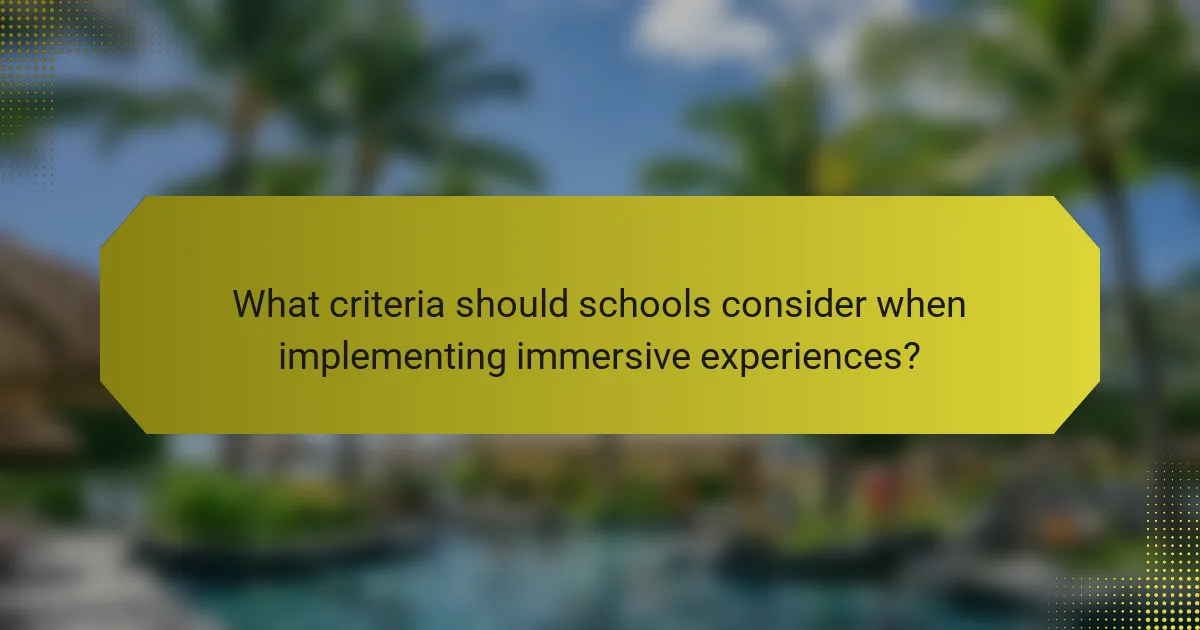
What criteria should schools consider when implementing immersive experiences?
Schools should evaluate several key criteria when implementing immersive experiences, including budget allocation, technology infrastructure, and teacher training programs. Each of these factors plays a crucial role in ensuring the successful integration of immersive learning methods into the curriculum.
Budget allocation
Budget allocation is essential for the successful implementation of immersive experiences. Schools must assess the costs associated with technology, content development, and ongoing maintenance. Allocating funds wisely can involve prioritizing high-impact areas such as virtual reality equipment or interactive software that engages students effectively.
Consider setting aside a percentage of the overall educational budget specifically for immersive experiences. For example, dedicating 5-10% can provide a solid foundation for initial investments while allowing for future expansions as technology evolves.
Technology infrastructure
A robust technology infrastructure is critical for supporting immersive experiences. Schools need reliable internet access, sufficient bandwidth, and compatible devices to ensure seamless operation of immersive tools. Evaluating existing infrastructure and identifying gaps will help in planning necessary upgrades.
Investing in high-quality hardware, such as VR headsets and interactive displays, is vital. Schools should also consider cloud-based solutions for content storage and collaboration, which can enhance accessibility and reduce local hardware costs.
Teacher training programs
Effective teacher training programs are necessary to equip educators with the skills to utilize immersive experiences. Professional development should focus on integrating technology into lesson plans and fostering an engaging learning environment. Training sessions can include hands-on workshops and ongoing support to address challenges as they arise.
Encouraging collaboration among teachers can enhance the learning experience. Schools might implement mentorship programs where experienced educators share best practices for using immersive tools, ensuring that all staff members feel confident in their ability to engage students effectively.
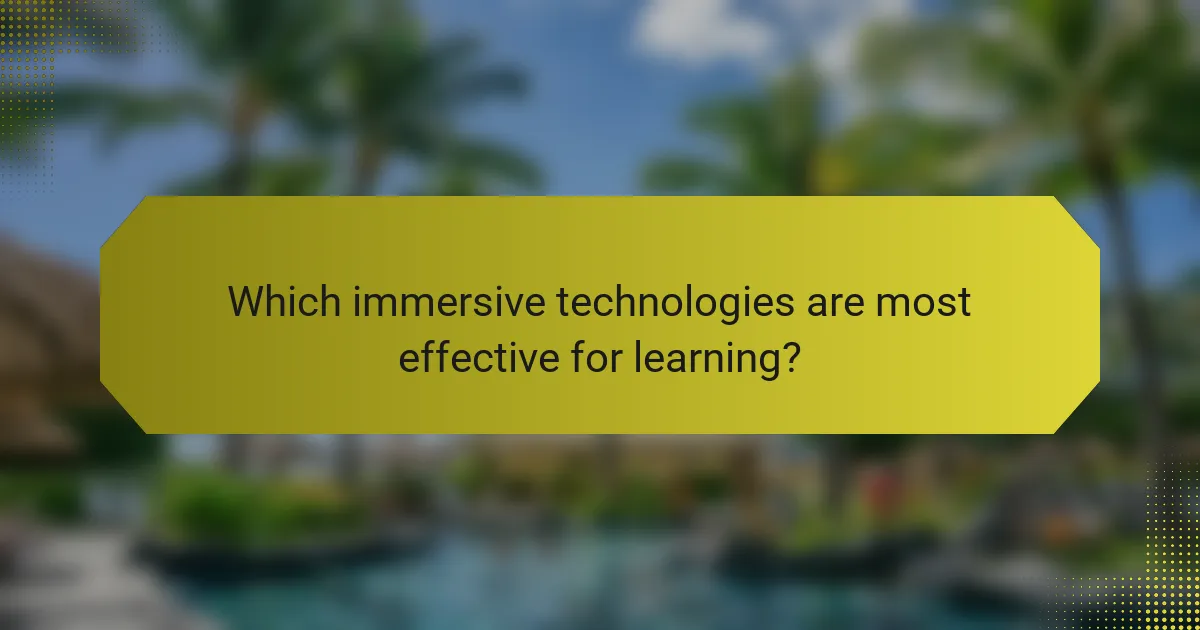
Which immersive technologies are most effective for learning?
Immersive technologies such as virtual reality (VR), augmented reality (AR), and interactive field trips significantly enhance learning by providing engaging, hands-on experiences. These technologies foster student engagement and retention by making complex concepts more accessible and memorable.
Oculus Quest for virtual reality
The Oculus Quest is a standalone VR headset that offers a range of educational applications. It immerses students in virtual environments where they can explore subjects like history, science, and art in a three-dimensional space.
When using Oculus Quest, educators should consider the content available and its alignment with curriculum goals. For instance, simulations in biology can allow students to interact with 3D models of cells, enhancing understanding through active participation.
To maximize effectiveness, ensure that students have adequate time to acclimate to VR environments, as initial experiences may cause discomfort for some users. Regular breaks and guided sessions can help mitigate this issue.
Microsoft HoloLens for augmented reality
Microsoft HoloLens is a mixed-reality headset that overlays digital information onto the real world, making it ideal for interactive learning. It allows students to visualize complex data and concepts in real-time, enhancing comprehension.
In practical applications, HoloLens can be used in engineering classes to visualize 3D models of structures, enabling students to manipulate and analyze designs. This hands-on approach can lead to deeper understanding and retention of material.
Educators should ensure that the content is engaging and relevant to the students’ learning objectives. Incorporating collaborative projects can also enhance the learning experience, as students work together to solve problems using AR tools.
Google Expeditions for field trips
Google Expeditions is an app that allows teachers to take students on virtual field trips to various locations around the world. This tool provides immersive experiences that can supplement traditional learning methods.
Using Google Expeditions, educators can guide students through historical sites, natural wonders, or even outer space, all from the classroom. This can be particularly beneficial for schools with limited resources for physical field trips.
To effectively implement Google Expeditions, teachers should prepare students beforehand by discussing the locations and themes of the trips. Following the expeditions, engaging students in discussions or projects can reinforce their learning and deepen their understanding of the material explored.
